
Concept explainers
(a)
Interpretation:
Name of the given organic compound should be determined.
Concept Introduction:
The group that contains carboxyl group which is attached to at least one hydrogen is said to be an
In order to give the name to the aldehyde group, the following steps are followed:
1. The parent (longest)
2. The ending of the parent chain from alkane (-e) is changed to -al for an aldehyde group. The carbonyl group of an aldehyde appear at the end of the carbon chain so, the numbering start with carbon having aldehyde group.
3. Name should be written in alphabetical order and other substituents are shown by the number.
For number of carbons atoms chain, the prefix is given as:
Carbon-1meth
Carbon-2eth
Carbon-3prop
Carbon-4but
Carbon-5pent
Carbon-6hex
Carbon-7hept
Carbon-8oct
Carbon-9non
Carbon-10dec.
Answer to Problem 145CP
Name of the given compound is:
Heptanal.
Explanation of Solution
The given structure is:

The parent chain in the given structure is heptane. Numbering is done in such a way that carbonyl carbon gets number 1.

So, the name will be: heptanal.
(b)
Interpretation:
Name of the given organic compound should be determined.
Concept Introduction:
The group that contains carboxyl group which is attached to at least one hydrogen is said to be an aldehyde group, general representation of an aldehyde group is RCH=O or RCHO. Whereas the group that contains carboxyl group which is attached to two carbon atoms is said to be a ketone group, general representation of a ketone group is RCOR’.
In order to give the name to the aldehyde group, the following steps are followed:
1. The parent (longest) alkane chain is identified.
2. The ending of the parent chain from alkane (-e) is changed to -al for an aldehyde group. The carbonyl group of an aldehyde appear at the end of the carbon chain so, the numbering start with carbon having aldehyde group.
3. Name should be written in alphabetical order and other substituents are shown by the number.
For number of carbons atoms chain, the prefix is given as:
Carbon-1meth
Carbon-2eth
Carbon-3prop
Carbon-4but
Carbon-5pent
Carbon-6hex
Carbon-7hept
Carbon-8oct
Carbon-9non
Carbon-10dec.
Answer to Problem 145CP
Name of the given compound is:
3-ethyl-5-methylhexanal.
Explanation of Solution
The given structure is:
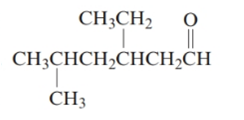
The parent chain in the given structure is hexane. Numbering is done in such a way that carbonyl carbon gets number 1.
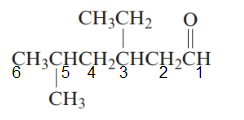
The substituent on 3 position is ethyl and on 5 position is methyl.
So, the name will be: 3-ethyl-5-methylhexanal.
(c)
Interpretation:
Name of the given organic compound should be determined.
Concept Introduction:
The group that contains carboxyl group which is attached to at least one hydrogen is said to be an aldehyde group, general representation of an aldehyde group is RCH=O or RCHO. Whereas the group that contains carboxyl group which is attached to two carbon atoms is said to be a ketone group, general representation of a ketone group is RCOR’.
In order to give the name to the ketone group, the following steps are followed:
1. The parent (longest) alkane chain is identified.
2. The ending of the parent chain from alkane (-e) is changed to -one for a ketone group.
3. The numbering is of the chain is done in such a way that carbonyl carbon gets the smaller number.
4. Name should be written in alphabetical order and other substituents are shown by the number.
For number of carbons atoms chain, the prefix is given as:
Carbon-1meth
Carbon-2eth
Carbon-3prop
Carbon-4but
Carbon-5pent
Carbon-6hex
Carbon-7hept
Carbon-8oct
Carbon-9non
Carbon-10dec.
Answer to Problem 145CP
Name of the given compound is:
Hexan-3-one.
Explanation of Solution
The given structure is:

The parent chain in the given structure is hexane. Numbering is done in such a way that carbonyl carbon gets lower number that is 3.

So, the name will be: Hexan-3-one.
(d)
Interpretation:
Name of the given organic compound should be determined.
Concept Introduction:
The group that contains carboxyl group which is attached to at least one hydrogen is said to be an aldehyde group, general representation of an aldehyde group is RCH=O or RCHO. Whereas the group that contains carboxyl group which is attached to two carbon atoms is said to be a ketone group, general representation of a ketone group is RCOR’.
In order to give the name to the ketone group, the following steps are followed:
1. The parent (longest) alkane chain is identified.
2. The ending of the parent chain from alkane (-e) is changed to -one for a ketone group.
3. The numbering is of the chain is done in such a way that carbonyl carbon gets the smaller number.
4. Name should be written in alphabetical order and other substituents are shown by the number.
For number of carbons atoms chain, the prefix is given as:
Carbon-1meth
Carbon-2eth
Carbon-3prop
Carbon-4but
Carbon-5pent
Carbon-6hex
Carbon-7hept
Carbon-8oct
Carbon-9non
Carbon-10dec.
Answer to Problem 145CP
Name of the given compound is:
4, 5-dimethylhexan-3-one.
Explanation of Solution
The given structure is:
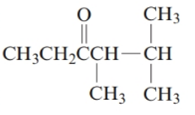
The parent chain in the given structure is hexane. Numbering is done in such a way that carbonyl carbon gets lower number that is 3.
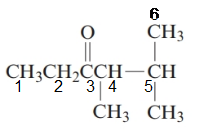
The substituent on 4 and 5 position is methyl.
So, the name will be: 4, 5-dimethylhexan-3-one.
(e)
Interpretation:
Name of the given organic compound should be determined.
Concept Introduction:
An organic compound in which carboxy
In order to give the name to the carboxylic acid group, the following steps are followed:
1. The parent (longest) alkane chain is identified.
2. The ending of the parent chain from alkane (-e) is changed to -oic acid for a carboxylic acid group.
3. The numbering is of the chain is done in such a way that carbonyl carbon gets the smaller number.
4. Name should be written in alphabetical order and other substituents are shown by the number.
For number of carbons atoms chain, the prefix is given as:
Carbon-1meth
Carbon-2eth
Carbon-3prop
Carbon-4but
Carbon-5pent
Carbon-6hex
Carbon-7hept
Carbon-8oct
Carbon-9non
Carbon-10dec.
Answer to Problem 145CP
Name of the given compound is:
3, 4-dimethylhexanoic acid.
Explanation of Solution
The given structure is:
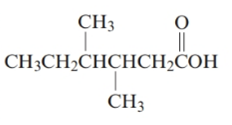
The parent chain in the given structure is hexane. Numbering is done in such a way that carboxyl group gets number 1.
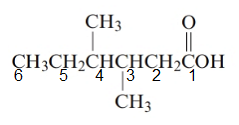
The substituent on 3 and 4 position is methyl.
So, the name will be: 3, 4-dimethylhexanoic acid.
Want to see more full solutions like this?
Chapter 20 Solutions
Introductory Chemistry: A Foundation
- Explain reasons as to why the amount of caffeine extracted from both a singular extraction (5ml Mountain Dew) and a multiple extraction (2 x 5.0ml Mountain Dew) were severely high when compared to coca-cola?arrow_forwardProtecting Groups and Carbonyls 6) The synthesis generates allethrolone that exhibits high insect toxicity but low mammalian toxicity. They are used in pet shampoo, human lice shampoo, and industrial sprays for insects and mosquitos. Propose detailed mechanistic steps to generate the allethrolone label the different types of reagents (Grignard, acid/base protonation, acid/base deprotonation, reduction, oxidation, witting, aldol condensation, Robinson annulation, etc.) III + VI HS HS H+ CH,CH,Li III I II IV CI + P(Ph)3 V ༼ Hint: no strong base added VI S VII IX HO VIII -MgBr HgCl2,HgO HO. isomerization aqeuous solution H,SO, ༽༽༤༽༽ X MeOH Hint: enhances selectivity for reaction at the S X ☑arrow_forwardDraw the complete mechanism for the acid-catalyzed hydration of this alkene. esc 田 Explanation Check 1 888 Q A slock Add/Remove step Q F4 F5 F6 A བྲA F7 $ % 5 @ 4 2 3 & 6 87 Click and drag to start drawing a structure. © 2025 McGraw Hill LLC. All Rights Reserved. Terms of Use | Privacy Ce W E R T Y U S D LL G H IK DD 요 F8 F9 F10 F1 * ( 8 9 0 O P J K L Z X C V B N M H He commandarrow_forward
- Explanation Check F1 H₂O H₂ Pd 1) MCPBA 2) H3O+ 1) Hg(OAc)2, H₂O 2) NaBH4 OH CI OH OH OH hydration halohydrin formation addition halogenation hydrogenation inhalation hydrogenation hydration ☐ halohydrin formation addition halogenation formation chelation hydrogenation halohydrin formation substitution hydration halogenation addition Ohalohydrin formation subtraction halogenation addition hydrogenation hydration F2 80 F3 σ F4 F5 F6 1 ! 2 # 3 $ 4 % 05 Q W & Å © 2025 McGraw Hill LLC. All Rights Reserved. F7 F8 ( 6 7 8 9 LU E R T Y U A F9arrow_forwardShow the mechanism steps to obtain the lowerenergy intermediate: *see imagearrow_forwardSoap is made by the previous reaction *see image. The main difference between one soap and another soap isthe length (number of carbons) of the carboxylic acid. However, if a soap irritates your skin, they mostlikely used too much lye.Detergents have the same chemical structure as soaps except for the functional group. Detergentshave sulfate (R-SO4H) and phosphate (R-PO4H2) functional groups. Draw the above carboxylic acidcarbon chain but as the two variants of detergents. *see imagearrow_forward
- Assign all the signals individually (please assign the red, green and blue)arrow_forwardThe two pKa values of oxalic acid are 1.25 and 3.81. Why are they not the same value? Show the protontransfer as part of your explanation. *see imagearrow_forwardасть Identify all the bonds that gauche interact with C-OMe in the most stable conformation of the above compound.arrow_forward
- Chemistry: Matter and ChangeChemistryISBN:9780078746376Author:Dinah Zike, Laurel Dingrando, Nicholas Hainen, Cheryl WistromPublisher:Glencoe/McGraw-Hill School Pub Co
 Living By Chemistry: First Edition TextbookChemistryISBN:9781559539418Author:Angelica StacyPublisher:MAC HIGHER
Living By Chemistry: First Edition TextbookChemistryISBN:9781559539418Author:Angelica StacyPublisher:MAC HIGHER Introductory Chemistry: A FoundationChemistryISBN:9781337399425Author:Steven S. Zumdahl, Donald J. DeCostePublisher:Cengage Learning
Introductory Chemistry: A FoundationChemistryISBN:9781337399425Author:Steven S. Zumdahl, Donald J. DeCostePublisher:Cengage Learning  Introductory Chemistry: An Active Learning Approa...ChemistryISBN:9781305079250Author:Mark S. Cracolice, Ed PetersPublisher:Cengage Learning
Introductory Chemistry: An Active Learning Approa...ChemistryISBN:9781305079250Author:Mark S. Cracolice, Ed PetersPublisher:Cengage Learning Chemistry for Today: General, Organic, and Bioche...ChemistryISBN:9781305960060Author:Spencer L. Seager, Michael R. Slabaugh, Maren S. HansenPublisher:Cengage Learning
Chemistry for Today: General, Organic, and Bioche...ChemistryISBN:9781305960060Author:Spencer L. Seager, Michael R. Slabaugh, Maren S. HansenPublisher:Cengage Learning





